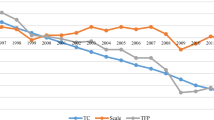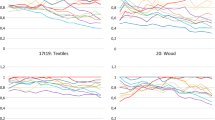Abstract
Total Factor Productivity (TFP) accounts for a sizable proportion of the income differences across countries. Two challenges remain to researchers aiming to explain these differences: on the one hand, TFP growth is hard to measure empirically; on the other hand, model uncertainty hampers consensus on its key determinants. This paper combines a non-parametric measure of TFP growth with Bayesian model averaging techniques in order to address both issues. Our empirical findings suggest that the most robust TFP growth determinants are time-invariant unobserved heterogeneity and trade openness. We also investigate the main determinants of two TFP components: efficiency change (i.e., catching up) and technological progress.
Similar content being viewed by others
Notes
In order to apply the method to our panel of countries, we consider the panel data version of the approach discussed in Moral-Benito (2012).
Only the country-specific effects are robust determinants of both TFP components, giving support to the importance of unobserved heterogeneity at the country level in TFP growth rates.
Details on the estimation of production frontiers by means of DEA can be found in Chapter 6 of Coelli et al. (1998).
For the sake of brevity we do not present here the results but are available from the authors upon request.
The list of countries, which includes 20 OECD and 47 non-OECD countries, is provided in Table 1.
Table 1 List of countries For instance, in this respect we only include one indicator of trade openness. These concerns are also echoed by Kraay and Tawara (2010) in a different context.
For example, the TFP growth indices for Algeria and Argentina are, respectively, 0.9991 and 1.008. Although these numbers are very similar, translated into growth terms, they indicate that while Algeria’s TFP performance is characterized by a yearly decline of 0.09 % on average, Argentina shows an average TFP growth of 0.18 % each year.
This situation resembles the literature on growth regressions since it is not clear which empirical specification must be preferred a priori.
Note also that the number of models to be estimated in the BMA setting is enormous and might be intractable in practice. In this paper, we consider the MC\(^3\) algorithm in order to overcome this computational issue (see Koop 2003).
This prior is a multivariate normal with mean the MLE of the parameters and variance the inverse of the expected Fisher information matrix for one observation.
For ease of interpretation we include \(\eta _i\) as a component of the error term but it can also be interpreted as a country-specific constant within the traditional fixed effects approach.
Since specification tests within the BMA setting are not available in the literature, we consider the estimates from the full model with all the candidate regressors included to conduct the specification tests in this section.
We also check this conclusion in Sect. 4.1 based on a Hausman test, and looking at the posterior inclusion probability of the country dummies as a whole.
Note that including some of these time invariant variables in our setting would require an additional identifying assumption, namely, independence between such regressors and the effects.
Note that the results in Table 5 for the case of uniform priors on the model space remain qualitatively unaltered when using the dilution priors (e.g., George 1999; Durlauf et al. 2008). In contrast to the uniform prior, the dilution prior assigns uniform probability to neighborhoods rather than models taking into account the correlations among regressors.
Note that this result also emerges in the subsamples of OECD and non-OECD countries; however, to save space these results are not reported but are available upon request.
Sala-i-Martin et al. (2004) note that in most cases, having a ratio of posterior mean to posterior standard deviation around two in absolute value indicates an approximate 95 % Bayesian coverage region that excludes zero.
The significant and negative coefficient on initial GDP gives evidence in favor of a convergence effect in the evolution of TFP across countries. Growth rates of TFP in poorer countries tend to be higher than in richer countries.
References
Abramovitz M (1956) Resources and output trends in the United States since 1870. Am Econ Rev 46:5–23
Acemoglu D (2010) When does labor scarcity encourage innovation? J Polit Econ 118:1037–1078
Acemoglu D, Johnson S, Robinson J (2001) The colonial origins of comparative development: an empirical investigation. Am Econ Rev 91:1369–1401
Badunenko O, Henderson D, Zelenyuk V (2008) Technological change and transition: relative contributions to worldwide growth during the 1990s. Oxf Bull Econ Stat 70:461–492
Barro R (1991) Economic growth in a cross section of countries. Q J Econ 106:407–443
Beaudry P, Green D (2002) Population growth, technological adoption, and economic outcomes in the information era. Rev Econ Dyn 5:749–774
Benhabib J, Spiegel M (1994) The role of human capital in economic development: evidence from aggregate cross-country data. J Monet Econ 34:143–174
Benhabib J, Spiegel M (2005) Human capital and technology diffusion. In: Aghion P, Durlauf S (eds) Handbook of economic growth, vol 4. North Holland, Elsevier, Amsterdam
Brock W, Durlauf S (2001) Growth empirics and reality. World Bank Econ Rev 15:229–272
Caselli F (2005) Accounting for cross-country income differences. In: Aghion P, Durlauf S (eds) Handbook of economic growth, vol 1. North Holland, Elsevier, Amsterdam
Caves D, Christensen L, Diewert W (1982a) The economic theory of index numbers and measurement of input, output and productivity. Econometrica 50:1393–1414
Caves D, Christensen L, Diewert W (1982b) Multilateral comparison of output, input and productivity using superlative index numbers. Econ J 92:73–86
Ciccone A, Jarocinski M (2010) Determinants of economic growth: will data tell? Am Econ J: Macroecon 4:222–246
Coelli T, Rao D, Battese G (1998) An introduction to efficiency and productivity analysis. Kluwer, Boston
Collins S, Bosworth B (1996) Economic growth in East Asia: accumulation versus assimilation. Brookings Pap Econ Act 2:135–203
Daraio C, Simar L (2007) Advanced robust and nonparametric methods in efficiency analysis: methodology and applications. Springer, New York
De Long B, Summers L (1991) Equipment investment and economic growth. Q J Econ 106:445–502
Durlauf S, Kourtellos A, Tan C (2008) Are any growth theories robust? Econ J 118:329–346
Easterly W (1993) How much do distortions affect growth? J Monet Econ 32:187–212
Easterly W, Levine R (2001) It’s not factor accumulation: stylized facts and growth models. World Bank Econ Rev 15:177–219
Eaton J, Kortum S (2001) Technology, trade, and growth: a unified framework. Eur Econ Rev 45:742–755
Eicher T, Papageorgiou C, Raftery A (2011) Default priors and predictive performance in Bayesian Model Averaging, with application to growth determinants. J Appl Econom 26:30–55
Färe R, Grosskopf S, Norris S, Zhang Z (1994) Productivity growth, technical progress, and efficiency change in industrialized countries. Am Econ Rev 84:66–83
Fernandez C, Ley E, Steel M (2001) Model uncertainty in cross-country growth regressions. J Appl Econom 16:563–576
Gallup J, Mellinger A, Sachs J (1999) Geography datasets. Center for International Development at Harvard University (CID)
George E (1999) Discussion of Bayesian model averaging and model search strategies. In: Bernardo J, Berger A, Dawid P (eds) Bayesian statistics. Oxford University Press, Oxford
Grossman G, Helpman E (1991) Innovation and growth in the global economy. MIT Press, Cambridge
Hall R, Jones C (1999) Why do some countries produce so much more output per worker than others? Q J Econ 114:83–116
Helpman E, Rangel A (1999) Adjusting to a new technology: experience and training. J Econ Growth 4:359–383
Isaksson A (2007) Determinants of total factor productivity: a literature review. Research and Statistics Staff Working Paper 2/2007, United Nations Industrial Development Organization, Vienna
Klenow P, Rodriguez-Clare A (1997) The neoclassical revival in growth economics: has it gone too far? NBER Macroeconomics Annual 12:73–102
Kneller R, Stevens P (2006) Frontier technology and absorptive capacity: evidence from OECD manufacturing industries? Oxf Bull Econ Stat 68:1–21
Koop G (2003) Bayesian econometrics. Wiley, New York
Koop G, Osiewalski J, Steel M (1999) The components of output growth: a stochastic frontier analysis. Oxf Bull Econ Stat 61:455–487
Kraay A, Tawara N (2010) Can disaggregated indicators identify governance reform priorities? World Bank Policy Research Working Paper 5254
Krüger J (2003) The global trends of total factor productivity: evidence from the nonparametric Malmquist index approach. Oxf Econ Pap 55:265–286
Krugman P (1994) The age of diminishing expectations: US Economic Policy in the 1990s. MIT Press, Cambridge
Kumar S, Russell R (2002) Technological change, technological catch-up, and capital deepening: relative contributions to growth and convergence. Am Econ Rev 92:527–548
Makiela K (2009) Economic growth decompositon. An empirical analysis using Bayesian frontier approach. Cent Eur J Econ Model Econom 1:333–369
Malmquist S (1953) Index numbers and indifference surfaces. Trabajos de Estadistica y de Investigacion Operativa 4:209–242
Miller S, Upadhyay M (2000) The effects of openness, trade orientation, and human capital on total factor productivity. J Dev Econ 63:399–423
Moral-Benito E (2011) Model averaging in economics. Working Paper Bank of Spain 1123
Moral-Benito E (2012) Determinants of economic growth: a Bayesian panel data approach. Rev Econ Stat 94:566–579
Nehru V, Dhareshwar A (1993) A new database on physical capital stock: sources, methodology and results. Revista de Analisis Economico 8:37–59
Pesaran H (2004) General diagnostic tests for cross section dependence in panels. Cambridge Working Papers in Economics 0435, University of Cambridge
Porter M, Stern S (2000) Measuring the ‘ideas’ production function: evidence from international patent output. NBER Working Paper, 7891
Raftery A (1995) Bayesian model selection in social research. Sociol Methodol 25:111–163
Romer P (1990) Endogenous technological change. J Polit Econ 98:71–102
Sala-i-Martin X, Doppelhofer G, Miller R (2004) Determinants of long-term growth: a Bayesian averaging of classical estimates (BACE) approach. Am Econ Rev 94:813–835
Simar L (2003) Detecting outliers in frontier models: a simple approach. J Prod Anal 20:391–424
Solow R (1957) Technical change and the aggregate production function. Rev Econ Stat 39:312–320
Suhariyanto K, Thirtle C (2001) Asian agricultural productivity and convergence. J Agric Econ 52:96–110
Valdes B (1999) Economic growth: theory, empirics and policy. Edward Elgar, Gloucester and Northampton
Vandenbussche J, Aghion P, Meghir C (2006) Growth, distance to frontier and composition of human capital. J Econ Growth 11:97–127
Wallich H (1969) Money and growth: a country cross-section analysis. J Money Credit Bank 1:281–302
Wooldridge J (2002) Econometric analysis of cross section and panel data. MIT Press, Cambridge
Acknowledgments
We would like to thank Atsu Amegashie, Cristian Bartolucci, Joan Llull, and Jonathan Temple for helpful comments and suggestions. We also thank an Associate Editor and two anonymous referees for insightful suggestions that led to a substantial improvement of the paper.
Author information
Authors and Affiliations
Corresponding author
Rights and permissions
About this article
Cite this article
Danquah, M., Moral-Benito, E. & Ouattara, B. TFP growth and its determinants: a model averaging approach. Empir Econ 47, 227–251 (2014). https://doi.org/10.1007/s00181-013-0737-y
Received:
Accepted:
Published:
Issue Date:
DOI: https://doi.org/10.1007/s00181-013-0737-y




